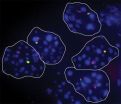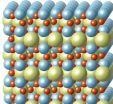(Press-News.org) Cold Spring Harbor, NY – We are a product of our parents. Maybe you have your mother's large, dark eyes, and you inherited your father's infectious smile. Both parents contribute one copy, or allele, of each gene to their offspring, so that we have two copies of every gene for a given trait – one from mom, the other from dad. In general, both copies of a gene are switched on or off as an embryo develops into an adult. The "switching on" of a gene begins the process of gene expression that ultimately results in the production of a protein.
Occasionally, a cell will arbitrarily begin to use of one copy of a gene over the other. The activation of only one member of a gene pair is called "monoallelic gene expression." In work published today in Developmental Cell, a team of researchers led by Professor David Spector at Cold Spring Harbor Laboratory (CSHL) shows that this random phenomenon is far more likely to be found in mature, developed cell types than in their stem cell precursors. This, in turn, offers an unexpected glimpse of randomness and variability in gene expression.
Cells are exquisitely sensitive to protein amounts: too much or too little can give rise to diseases, including cancer. For example, certain proteins, called tumor suppressors, act as "stop" signals to restrain cell growth. A cell with only half the dosage of such a protein may become the seed of a tumor. Random monoallelic gene expression cuts the amount of a protein by half, suggesting that this type of variability may have significant implications for disease.
Spector and Mélanie Eckersley-Maslin, Ph.D., lead author on the new paper, found that monoallelic gene expression is truly a random process. "It is not deterministic in any way," says Spector. "This significant amount of flexibility and randomness in gene expression is important for adaptation as a species evolves, but it is unclear how it functions in organisms today."
To better understand when monoallelic gene expression is established, Spector and his team collaborated with researchers from the European Molecular Biology Laboratory. The team used advanced sequencing technology and analysis tools to globally assess allele usage in two different cell types. They compared embryonic stem cells, which can change, or "differentiate," into nearly any type of tissue, with cells that had already differentiated into the precursors of neurons. They found a 5.6-fold increase in the number of monoallelically expressed genes in the differentiated cells. "As differentiation occurs, there is a dramatic change in gene expression as a specific program or set of genes is selected to be expressed and a massive reorganization occurs in the nucleus," says Spector. "It is these enormous changes that lead to stochastic (i.e., variable) monoallelic expression."
The team was surprised to find that 8% of the monoallelically expressed genes were able to boost their level of expression to compensate for what would otherwise be a shortfall. The researchers speculate that the cell may require higher amounts of protein from those genes. "This work raises many important questions," says Spector, "such as: how does the cell know how much of each protein to produce? How much flexibility is there? What is the tipping point toward disease?" The team continues to explore these fascinating questions.
INFORMATION:
This work was supported by the National Institute of General Medical Sciences and the National Cancer Institute, a Genentech Foundation Fellowship, George A. and Marjorie H. Anderson Fellowship, Deutscher Akademischer Austauschdienst Postdoctoral Fellowship, the European Molecular Biology Laboratory, and the Wellcome Trust.
"Random Monoallelic Gene Expression Increases upon Embryonic Stem Cell Differentiation" appears online in Developmental Cell on February 24, 2014. The authors are: Mélanie A. Eckersley-Maslin, David Thybert, Jan H. Bergmann, John C. Marioni, Paul Flicek, and David L. Spector. The paper can be obtained online at: http://www.cell.com/developmental-cell/home
About Cold Spring Harbor Laboratory Founded in 1890, Cold Spring Harbor Laboratory (CSHL) has shaped contemporary biomedical research and education with programs in cancer, neuroscience, plant biology and quantitative biology. CSHL is ranked number one in the world by Thomson Reuters for the impact of its research in molecular biology and genetics. The Laboratory has been home to eight Nobel Prize winners. Today, CSHL's multidisciplinary scientific community is more than 600 researchers and technicians strong and its Meetings & Courses program hosts more than 12,000 scientists from around the world each year to its Long Island campus and its China center. For more information, visit http://www.cshl.edu.
Like mom or dad? Some cells randomly express one parent's version of a gene over the other
Team finds that some cells activate only one of their two gene copies during development, altering protein yields and raising new questions
2014-02-24
ELSE PRESS RELEASES FROM THIS DATE:
Caring for patients with multiple chronic conditions -- New research and future challenges
2014-02-24
Philadelphia, Pa. (February 21, 2014) – The millions of Americans living with more than one chronic disease are at high risk of poor health outcomes, and account for a disproportionate share of health care costs. A special March supplement to Medical Care presents updates from the Agency for Healthcare Research and Quality's (AHRQ) Multiple Chronic Conditions (MCC) Research Network, formed to address knowledge gaps and research challenges in meeting the complex health care needs of this growing population. The journal is published by Lippincott Williams & Wilkins, a part ...
Nearly half of uninsured children live in immigrant families, reports study in Medical Care
2014-02-24
Philadelphia, Pa. (February 21, 2014) – Children from immigrant families now account for 42 percent of uninsured children in the United States, reports a study in the March issue of Medical Care. The journal is published by Lippincott Williams & Wilkins, a part of Wolters Kluwer Health.
More than two-thirds of uninsured children with immigrant parents are US citizens, according to an analysis of nationwide survey data by Eric E. Seiber, PhD, of The Ohio State University College of Public Health, Columbus. He writes, "Initiatives to expand coverage or increase Medicaid ...
Preventing suicide should start in a general medical setting
2014-02-24
The mental health conditions of most people who commit suicide remain undiagnosed, even though most visit a primary care provider or medical specialist in the year before they die. To help prevent suicides, health care providers should therefore become more attuned to their patients' mental health state and possible suicide ideation. These are the findings of Brian Ahmedani from the Henry Ford Health System in Detroit, Michigan, in a new study¹ documenting the type and timing of health services sought by Americans who commit suicide. The study is the largest geographically ...
Did you hear the one about the doctor?
2014-02-24
LEBANON, NH (Feb. 24, 2014) – In a study that demonstrates the potential of using social networking sites for research on health and medicine, Dartmouth researchers studied jokes made about doctors posted on Facebook.
"Social networking sites, such as Facebook, have become immensely popular in recent years and present a unique opportunity for researchers to eavesdrop on the collective conversation of current societal issues," said Matthew Davis of The Dartmouth Institute of Health Policy & Clinical Practice.
In one of the first studies of social networking site conversations ...
Exclusive David Gancberg article in Human Gene Therapy
2014-02-24
New Rochelle, NY, February 24, 2014—Over the past three funding stages, the European Commission has invested nearly $475 million in 100 projects in the gene transfer and gene therapy field. David Gancberg, Directorate-General for Research and Innovation, European Commission (Brussels), describes the substantial opportunities for funding to support basic and clinical research in gene and cell therapy to find new treatments for chronic and rare diseases and novel regenerative medicine approaches in a Commentary article in Human Gene Therapy, a peer-reviewed journal from Mary ...
Volcanoes contribute to recent warming 'hiatus'
2014-02-24
LIVERMORE, Calif. -- Volcanic eruptions in the early part of the 21st century have cooled the planet, according to a study led by Lawrence Livermore National Laboratory. This cooling partly offset the warming produced by greenhouse gases.
Despite continuing increases in atmospheric levels of greenhouse gases, and in the total heat content of the ocean, global-mean temperatures at the surface of the planet and in the troposphere (the lowest portion of the Earth's atmosphere) have shown relatively little warming since 1998. This so-called 'slow-down' or 'hiatus' has received ...
Personalized medicine best way to treat cancer, study argues
2014-02-24
If a driver is traveling to New York City, I-95 might be their route of choice. But they could also take I-78, I-87 or any number of alternate routes. Most cancers begin similarly, with many possible routes to the same disease. A new study found evidence that assessing the route to cancer on a case-by-case basis might make more sense than basing a patient's cancer treatment on commonly disrupted genes and pathways.
The study found little or no overlap in the most prominent genetic malfunction associated with each individual patient's disease compared to malfunctions ...
On the road to Mottronics
2014-02-24
"Mottronics" is a term seemingly destined to become familiar to aficionados of electronic gadgets. Named for the Nobel laureate Nevill Francis Mott, Mottronics involve materials – mostly metal oxides - that can be induced to transition between electrically conductive and insulating phases. If these phase transitions can be controlled, Mott materials hold great promise for future transistors and memories that feature higher energy efficiencies and faster switching speeds than today's devices. A team of researchers working at Berkeley Lab's Advanced Light Source (ALS) have ...
New ideas change your brain cells: UBC research
2014-02-24
A new University of British Columbia study identifies an important molecular change that occurs in the brain when we learn and remember.
Published this month in Nature Neuroscience, the research shows that learning stimulates our brain cells in a manner that causes a small fatty acid to attach to delta-catenin, a protein in the brain. This biochemical modification is essential in producing the changes in brain cell connectivity associated with learning, the study finds.
In animal models, the scientists found almost twice the amount of modified delta-catenin in the brain ...
Bushfires continue to plague Victoria, Australia
2014-02-24
Reports coming from Australia are more positive than negative now with regards to the Morwell fire, but officials say they still have a "long way to go." Considerable progress has been made in extinguishing the fire, but there is still significant heat that continues to generate smoke from the open mine. Fire activity has been cut in half since February 11, but there are still "weeks of firefighting ahead" according to Craig Lapsley, Fire Services Commissioner on the County Fire Authority website.
According to the Australian News, "The [Morwell] fire, which started ...
LAST 30 PRESS RELEASES:
New expert guidance urges caution before surgery for patients with treatment-resistant constipation
Solar hydrogen can now be produced efficiently without the scarce metal platinum
Sleeping in on weekends may help boost teens’ mental health
Study: Teens use cellphones for an hour a day at school
After more than two years of war, Palestinian children are hungry, denied education and “like the living dead”
The untold story of life with Prader-Willi syndrome - according to the siblings who live it
How the parasite that ‘gave up sex’ found more hosts – and why its victory won’t last
When is it time to jump? The boiling frog problem of AI use in physics education
Twitter data reveals partisan divide in understanding why pollen season's getting worse
AI is quick but risky for updating old software
Revolutionizing biosecurity: new multi-omics framework to transform invasive species management
From ancient herb to modern medicine: new review unveils the multi-targeted healing potential of Borago officinalis
Building a global scientific community: Biological Diversity Journal announces dual recruitment of Editorial Board and Youth Editorial Board members
Microbes that break down antibiotics help protect ecosystems under drug pollution
Smart biochar that remembers pollutants offers a new way to clean water and recycle biomass
Rice genes matter more than domestication in shaping plant microbiomes
Ticking time bomb: Some farmers report as many as 70 tick encounters over a 6-month period
Turning garden and crop waste into plastics
Scientists discover ‘platypus galaxies’ in the early universe
Seeing thyroid cancer in a new light: when AI meets label-free imaging in the operating room
Neutrophil-to-lymphocyte ratio may aid risk stratification in depressive disorder
2026 Seismological Society of America Annual Meeting
AI-powered ECG analysis offers promising path for early detection of chronic obstructive pulmonary disease, says Mount Sinai researchers
GIMM uncovers flaws in lab-grown heart cells and paves the way for improved treatments
Cracking the evolutionary code of sleep
Medications could help the aging brain cope with surgery, memory impairment
Back pain linked to worse sleep years later in men over 65, according to study
CDC urges ‘shared decision-making’ on some childhood vaccines; many unclear about what that means
New research finds that an ‘equal treatment’ approach to economic opportunity advertising can backfire
Researchers create shape-shifting, self-navigating microparticles
[Press-News.org] Like mom or dad? Some cells randomly express one parent's version of a gene over the otherTeam finds that some cells activate only one of their two gene copies during development, altering protein yields and raising new questions




